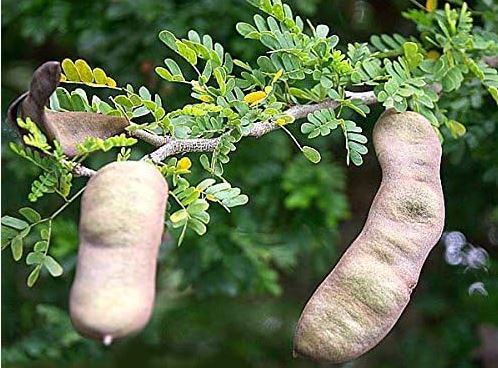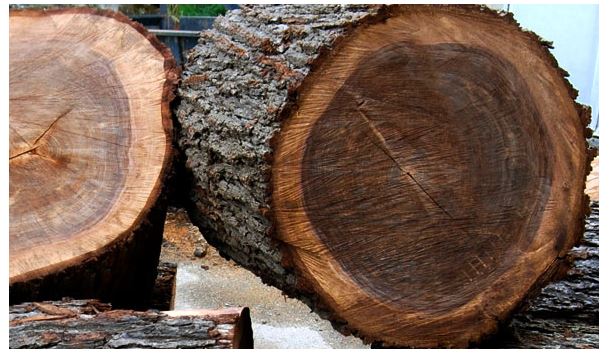
The term “ebony tree” commonly refers to several species within the genus Diospyros in the Ebenaceae family, with Diospyros ebenum (Ceylon ebony) and Diospyros crassiflora (Gabon ebony) being among the most prominent. The Diospyros genus includes over 700 species of trees and shrubs, many of which produce the dense, dark heartwood known as ebony. These species are typically evergreen or deciduous, depending on the climate, and are closely related to persimmons (Diospyros kaki). The Ebenaceae family is characterized by its hard, durable wood and small, often inconspicuous flowers. While Diospyros species vary, the ebony-producing ones are prized for their unique wood properties, placing them in a distinct horticultural and economic category.
Ebony trees are medium-sized, typically growing 20–80 feet (6–25 meters) tall, with a slow growth rate. Their leaves are usually elliptical, glossy, and dark green, measuring 2–6 inches (5–15 cm) long, with a leathery texture. The bark is dark and rough, often appearing charred in species like Diospyros ebenum. The most defining feature is the heartwood, which is jet-black or deep brown, dense enough to sink in water, and finely textured with a mirror-like polish when finished. Sapwood contrasts sharply, appearing light yellowish-gray or creamy white. Flowers are small, white to yellowish, and unisexual, while fruits resemble small persimmons, about 0.8–2 inches (2–5 cm) in diameter, often reddish or green when ripe. The wood’s hardness and weight (up to 1,200 kg/m³) distinguish it from other hardwoods.
Ebony trees are native to tropical and subtropical regions, with specific species tied to distinct areas. Diospyros ebenum is endemic to southern India, Sri Lanka, and parts of Indonesia, thriving in lowland forests. Diospyros crassiflora originates in the moist forests of the Congo Basin in Central Africa, particularly Cameroon, Gabon, and Nigeria. Other species, like Diospyros celebica (Sulawesi ebony), are native to Indonesia, and Diospyros humilis (Queensland ebony) is found in northern Australia and New Guinea. Due to their valuable wood, many ebony species have been overexploited, leading to restricted natural populations. Some are cultivated or naturalized outside their native ranges, but commercial harvesting primarily relies on wild or managed stands in their origin regions.
Ebony trees thrive in USDA zones 10–12, requiring warm, frost-free climates with temperatures rarely dipping below 40°F (4°C). They prefer tropical or subtropical conditions with high humidity and consistent rainfall, though they can tolerate brief dry periods. In colder zones, they are unsuitable for outdoor cultivation and are rarely grown as ornamentals due to their slow growth and specific soil needs. In their native ranges, they flourish in zones equivalent to 11–12, where temperatures stay between 60°F and 100°F (16°C–38°C). Outside these zones, ebony trees are impractical for landscaping and are instead valued for imported wood products.
Ebony wood is renowned for its use in high-end furniture, cabinetry, and decorative veneers due to its striking black color, durability, and ability to take a high polish. It is a preferred material for musical instruments, including piano keys, guitar fretboards, and violin fingerboards, owing to its density and smooth texture. Artisans use it for carvings, knife handles, and turned objects like chess pieces, valuing its fine grain and resistance to wear. Historically, ebony was used for scepters, drinking cups, and ornamental items in ancient cultures, attributed with symbolic or even medicinal properties. Beyond wood, ebony trees have limited practical uses—fruits are edible but not commercially significant, and the trees are rarely planted for shade or landscaping due to their slow growth and conservation concerns. Overharvesting has led to strict regulations, particularly for Diospyros ebenum, making sustainable sourcing critical.

Cultivation of Ebony Tree
Climate Requirements
Ebony trees thrive in tropical to subtropical climates, ideally in USDA zones 10–12, where temperatures range from 60°F to 100°F (16°C–38°C). They require frost-free conditions, as temperatures below 40°F (4°C) can damage young trees or stunt growth. High humidity (50–80%) mimics their native rainforest or monsoon forest habitats.
Site Selection
Choose a location with partial to full sun exposure, receiving at least 6–8 hours of sunlight daily. While young trees tolerate some shade, mature ebony trees prefer open areas for optimal growth. Ensure the site is sheltered from strong winds, which can damage brittle branches or stress the tree.
Soil Preferences
Plant in well-draining, fertile soil with a pH of 5.5–7.0. Ebony trees favor loamy or sandy loam soils rich in organic matter but can adapt to slightly clayey soils if drainage is adequate. Poor drainage leads to root rot, so incorporate compost or sand to improve soil structure if needed.
Propagation Methods
Propagate primarily through seeds, as cuttings are difficult to root. Soak fresh seeds in warm water for 24 hours to soften the hard coat, then plant in a seed-starting mix. Germination takes 2–6 weeks at 75–85°F (24–29°C). Grafting is sometimes used for specific cultivars, but it’s less common due to technical challenges.
Planting Process
Plant seedlings in early spring or the rainy season to ensure adequate moisture. Dig a hole twice the width of the root ball and as deep, spacing trees 15–25 feet (4.5–7.5 meters) apart to account for their canopy spread. Backfill with a mix of soil and compost, ensuring the root collar is level with the ground.
Watering Needs
Water young trees regularly to keep soil consistently moist but not waterlogged, about 1–2 inches per week for the first two years. Mature ebony trees are drought-tolerant but benefit from occasional deep watering during prolonged dry spells. Avoid overwatering, as soggy soil promotes fungal diseases.
Fertilization
Apply a balanced, slow-release fertilizer (e.g., 10-10-10 NPK) twice yearly—once in early spring and once in late summer—for young trees to boost growth. Mature trees require minimal feeding, but a light application of organic compost annually supports soil health. Avoid excessive nitrogen, which can weaken wood quality.
Pruning
Prune sparingly to maintain shape and remove dead or damaged branches. Perform light pruning in late winter or early spring before new growth begins, using clean, sharp tools to prevent disease. Avoid heavy pruning, as ebony trees grow slowly and may struggle to recover from significant cuts.
Pest Management
Monitor for pests like scale insects, mealybugs, or wood-boring beetles, which can target stressed trees. Treat infestations with neem oil or insecticidal soap, applied early in the morning. Healthy trees are less susceptible, so prioritize proper watering and nutrition to minimize pest risks.
Disease Prevention
Ebony trees are prone to root rot in poorly drained soils and fungal leaf spots in overly humid conditions. Ensure good air circulation by spacing trees adequately and avoiding overhead watering. Apply a copper-based fungicide if leaf spots appear, and remove affected debris to prevent spread.
Mulching
Apply a 2–3 inch (5–7.5 cm) layer of organic mulch, such as bark or wood chips, around the base, keeping it 3 inches (7.5 cm) from the trunk to prevent rot. Mulch conserves moisture, regulates soil temperature, and suppresses weeds, which is critical for slow-growing ebony trees competing for resources.
Growth Monitoring
Expect slow growth, with trees gaining only 1–2 feet (30–60 cm) per year under optimal conditions. Monitor for signs of stress, such as yellowing leaves (overwatering or nutrient deficiency) or wilting (underwatering or root issues). Patience is key, as ebony trees take decades to reach maturity and produce valuable heartwood.
Conservation Considerations
Due to overharvesting, many ebony species are endangered or protected (Diospyros ebenum is listed under CITES). Source seeds or seedlings from reputable, sustainable nurseries to avoid contributing to illegal logging. Consider planting as part of reforestation efforts or for long-term wood production under regulated management to support conservation.